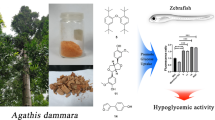Abstract
Bioassay-guided fractionation of the MeOH extract of Magnolia grandiflora seeds resulted in the isolation of a new dimeric neolignan, named bishonokiol A (1), as well as two known neolignans magnolol (2) and honokiol (3). The structures of the compounds were determined on the basis of data obtained using NMR and MS. Bishonokiol A (1) showed potent anti-proliferative activities in four human cancer cell lines, with IC50 values ranging from 5.1 to 7.5 µM. Additionally, bishonokiol A (1) induced apoptosis, as well as down-regulated the expression of the anti-apoptotic protein Bcl-2 and caspase-3 cleavage in HepG2 cell line.




Similar content being viewed by others
References
Arora, S., S. Singh, G.A. Piazza, C.M. Contreras, J. Panyam, and A.P. Singh. 2012. Honokiol: A novel natural agent for cancer prevention and therapy. Current Molecular Medicine 10: 1244–1252.
Baker, D.D., M. Chu, U. Oza, and V. Rajgarhia. 2007. The value of natural products to future pharmaceutical discovery. Natural Product Reports 24: 1225–1244.
Clark, A.M., A.S. EI-Feraly, and W.S. Li. 1981. Antimicrobial activity of phenolic constituents of Magnolia grandiflora L. Journal of Pharmaceutical Sciences 70(8): 951–952.
Del Valle Mondragón, L., F.A. Tenorio López, J.C. Torres Narváez, G.G. Zarco Olvera, and G. Pastelín Hernández. 2004. Estudio de los extractos de Magnolia grandiflora sobreel músculo cardíacode cobayo. Archivos de Cardiologia de Mexico 74: 108–117.
Feltenstein, M.W., W. Schühly, J.E. Warnick, N.H. Fischer, and K.J. Sufka. 2004. Anti-inflammatory and anti-hyperalgesic effects of sesquiterpene lactones from Magnolia and Bear’s Foot. Pharmacology Biochemistry and Behavior 79: 299–302.
Ito, K., T. Iida, K. Ichino, M. Tsunezuka, M. Hattori, and T. Namba. 1982. Obovatol and obovatal, novel biphenyl ether lignans from the leaves of Magnolia obovata Thunb. Chemical & Pharmaceutical Bulletin 30(9): 3347–3353.
Lee, S.K., H.N. Kim, Y.R. Kang, C.W. Lee, H.M. Kim, D.C. Han, J. Shin, K.H. Bae, and B.M. Kwon. 2008. Obovatol inhibits colorectal cancer growth by inhibiting tumor cell proliferation and Inducing apoptosis. Bioorganic & Medicinal Chemistry 16: 8397–8402.
Mohamed, S.M., E.M. Hassan, and N.A. Ibrahim. 2010. Cytotoxic and antiviral activities of aporphine alkaloids of Magnolia grandiflora L. Natural Product Reports 24(15): 1395–1402.
Ngo, L.T., J.I. Okogun, and W.R. Folk. 2013. 21st century natural product research and drug development and traditional medicines. Natural Product Reports 30(4): 584–592.
Oh, J.H., L.L. Kang, J.O. Ban, Y.H. Kim, K.H. Kim, S.B. Han, and J.T. Hong. 2009. Anti-inflammatory effect of 4-O-methylhonokiol, a novel compound isolated from Magnolia officinalis through inhibition of NF-κΒ. Chemico-Biological Interactions 190: 506–514.
Schuehly, W., W. Voith, H. Teppner, and O. Kunert. 2010. Substituted dineolignans from Magnolia garrettii. Journal of Natural Products 73: 1381–1384.
Schühly, W., I. Khan, and N.H. Fischer. 2001. The ethnomedicinal uses of Magnoliaceae from the Southeastern United States as leads in drug discovery. Pharmaceutical Biology 39: 63–69.
Schühly, W., S.I. Khan, and N.H. Fischer. 2009. Neolignans from north American Magnolia species with cyclooxygenase 2 inhibitory activity. Inflammopharmacology 17: 106–110.
Shen, C.C., C.L. Ni, Y.C. Shen, Y.L. Huang, C.H. Kuo, T.S. Wu, and C.C. Chen. 2009. Phenolic constituents from the stem bark of Magnolia officinalis. Journal of Natural Products 72: 168–171.
Surh, Y.J. 2003. Cancer chemoprevention with dietary phytochemicals. Nature Reviews Cancer 3(10): 768–780.
Yu, J.Y., J.J. Lee, J.K. Jung, Y.K. Min, J.Y. Ma, T.J. Kim, M.Y. Lee, and Y.P. Yun. 2012. Anti- platelet activity of diacetylated obovatol through regulating cyclooxygenase and lipoxygenase activities. Archives of Pharmacal Research 5(12): 2191–2198.
Acknowledgments
This work was financially supported by the National Natural Science Foundation of China under Grant (no. 81302671, 81372899); the Natural Science Foundation of Anhui Province under Grant (no. 1408085QH162); the Natural Science Foundation of Bengbu Medical College under Grant (Bykf1326).
Author information
Authors and Affiliations
Corresponding author
Additional information
Hong-Mei Li and Su-Rong Zhao have contributed equally to this work.
Rights and permissions
About this article
Cite this article
Li, HM., Zhao, SR., Huo, Q. et al. A new dimeric neolignan from Magnolia grandiflora L. seeds. Arch. Pharm. Res. 38, 1066–1071 (2015). https://doi.org/10.1007/s12272-014-0476-4
Received:
Accepted:
Published:
Issue Date:
DOI: https://doi.org/10.1007/s12272-014-0476-4




